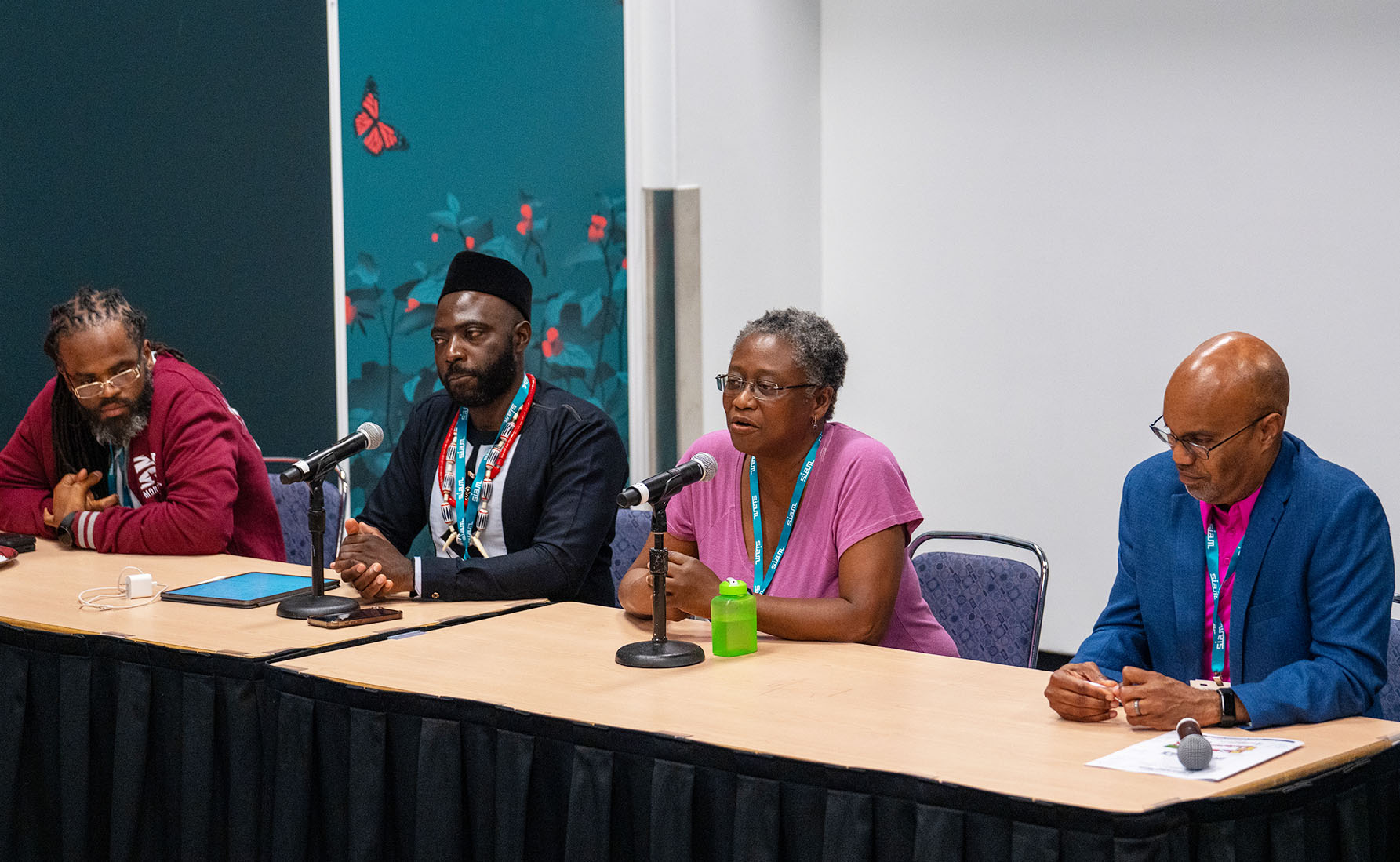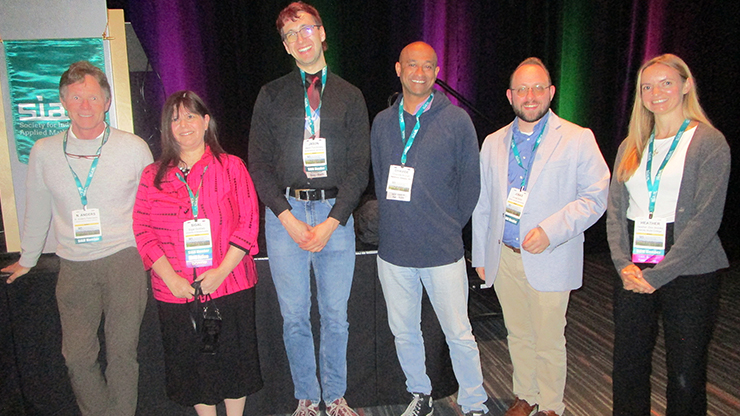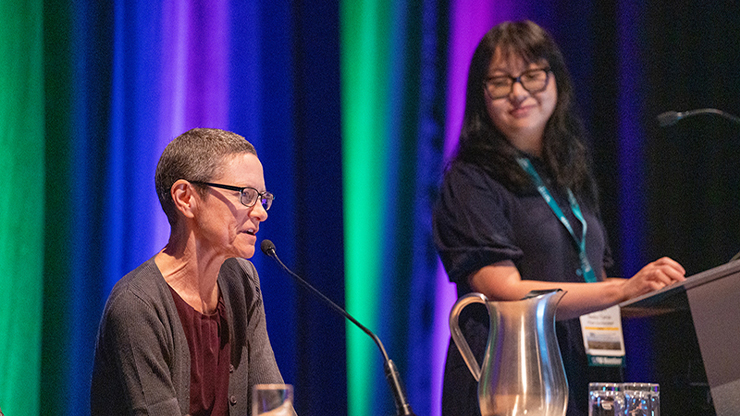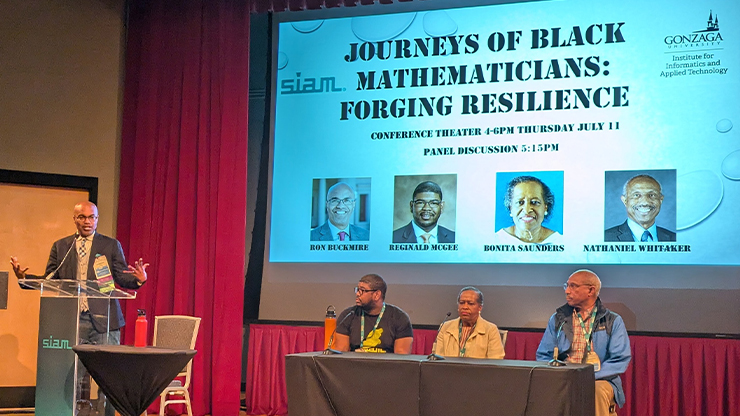AN25 Film Screening and Panel Discussion Continue Conversation About the Journeys of Black Mathematicians
Last year’s 2024 SIAM Annual Meeting, which took place in Spokane, Wash., featured a film screening and discussion of Journeys of Black Mathematicians: Forging Resilience [1]. The documentary, which was created by George Csicsery and jointly commissioned by ZALA Films and the Simons Laufer Mathematical Sciences Institute, explores the personal stories of Black mathematicians. Following that successful screening, the Third Joint SIAM/CAIMS Annual Meetings (AN25)—which were held this past summer in Montréal, Québec, Canada—included a consequent session that was sponsored by the Workshop Celebrating Diversity; SIAM Activity Group on Equity, Diversity, and Inclusion (EDI); and Canadian Applied and Industrial Mathematics Society’s (CAIMS) Equity, Diversity, Inclusiveness and Membership Committee.
This special event opened with a showing of the second installment in Csicsery’s film series, titled Journeys of Black Mathematicians: Creating Pathways. Released in 2025, the new documentary spotlights additional present-day researchers, celebrates the lives of pioneering Black mathematicians from the 20th century, and addresses the impacts of segregation and discrimination. After the screening, Ron Buckmire of Marist College—former SIAM Vice President for EDI—moderated an insightful conversation between Lucy Campbell of Carleton University in Canada, Jude Kong of the University of Toronto, and Zerotti Woods of Johns Hopkins University. Throughout the hourlong discussion, panelists shared their personal experiences and affirmed the importance of EDI in the mathematical sciences.
The speakers introduced themselves by overviewing their individual pathways into mathematics. Campbell, an associate professor at Carleton, discovered her passion for the subject at just three years old. “Early on, I started to show an interest in and aptitude for math,” she said. “I was always talking about numbers. Fortunately for me, I come from a family of teachers.” Campbell’s mother, who was born in Ghana, was a teacher and herself descended from a line of teachers; her father was a group theorist and mathematics professor from Barbados.

As an educator, Campbell’s mother observed and nourished her daughter’s penchant for mathematics. “She saw right away that I was interested in math,” Campbell continued. “It seemed like a natural choice because my father was a mathematician. For all my life, I saw myself as someone who would be doing math.” As she progressed in her studies, Campbell was excited by the realization that she could pursue a career that allowed her to both teach and conduct research.
Kong, an assistant professor at Toronto, spoke about his upbringing with four siblings in a remote area of Cameroon — where community was the focal point of all endeavors. As a student in primary school, his thoughts centered on how he could best support his family and especially his mother, who worked on a farm. “There was no time when I thought I would be a mathematician,” he said, noting that many people in his hometown did not attend secondary school. However, Kong’s attention to community was the driving factor that ultimately ensured his academic success; he sought to perform well academically to earn the respect of his friends and peers.
Kong explained that he felt a particular sense of pride when solving math problems. “That excited me and kept me doing the same thing over and over,” he said, adding that he regularly shared his knowledge with friends to help them learn and keep them out of trouble. “That resilience is because of community.” Yet despite his talent, Kong did not immediately recognize his own propensity for math; he simply saw his actions as a service to the collective whole.
Like Kong, Woods—a chief scientist in Johns Hopkins’ Applied Physics Laboratory—also recalled helping his classmates with math assignments as a child. After earning a B.S. in mathematics from Morehouse College, he enrolled in a rigorous graduate program at the University of Georgia. The first year, he did not pass his qualifying exams; his graduate advisor told him that he would likely fail out of the program entirely and would need to finish his degree elsewhere. Rather than surrender to this lack of encouragement, Woods turned the expectation for failure into a sense of determination and set out to complete the curriculum and prove his capability.
Kong remarked that the traditional higher education system is not designed to accommodate individuals from underrepresented backgrounds, who often receive less support from instructors, advisors, and peers. He therefore seeks to cultivate a sense of community and togetherness within his classroom whenever possible. “The first thing I always talk about is that community piece and family-oriented way of teaching,” he said. “I try to get people to feel like they’re part of this, like someone will take what they say into account.”
To prevent the disengagement of students from marginalized backgrounds via the so-called “leaky pipeline,” Kong urged academics to develop microcommunities where women, people of color, first-generation college students, and other minoritized groups can find a safe landing space in the face of challenges. “No matter how a single person makes them feel due to conscious or unconscious bias, they’ll know that they have a microcommunity,” he said. “They’ll feel like they’re not alone in what they’re going through.” For example, Kong specifically reached out to all of his Black students during the COVID-19 pandemic—a particularly difficult time for many people—to schedule regular group check-ins and offer support.
As a Black woman with a higher degree in applied mathematics, Campbell is personally familiar with the leaky pipeline phenomenon. From a young age, she was acutely aware that she was different. “I was always the only girl in the science class, the only girl in the advanced math class,” she said. This sense of isolation became even more pronounced throughout her graduate studies in the U.K. and Canada, as Campbell was frequently the sole Black person and sole female in the room. “What kept me going through all of this was coming from a family of very powerful, strong women,” she continued, explaining that her family’s educational values protected her from the full effects of imposter syndrome. “I didn’t feel like much of an imposter because I’d had this interest forever.” In a way, Campbell’s family served as her own microcommunity — a counternarrative to any negativity.
Conversation next turned to the importance of EDI in the workforce, with the panelists collectively agreeing that the very concept of diversity inherently encompasses all people, not just certain groups. Kong surmised that critics of EDI-focused programs perhaps misunderstand the all-inclusive definition of EDI. “Politicians can act on emotions and not facts,” he said, noting that opponents of EDI often erroneously believe that it only serves the interests of women, people of color, or other marginalized communities. He thus advocated for more transparent messaging about the intent of EDI initiatives. “What communication piece is missing that has led to that misinformation spreading?” Kong asked. “EDI is not to give handouts to people; it’s to advance science and get different feedback. But that communication is lacking, so how can we advance it?”
Campbell seconded Kong’s comments on misinformation and acknowledged the additional dangers of disinformation: the intentional spread of falsehoods to advance a particular agenda. “It’s more than just a misunderstanding,” she said. “It’s deliberately giving false information and knowing that people will listen and take what is said.”
Woods touted the value of open dialogue between people of all backgrounds, revealing that he has had interesting, nuanced conversations with individuals who did not face the same roadblocks or biases in their educational or career journeys. These sorts of honest discussions expose everyone to a broader range of viewpoints and can validate the experiences of individuals from underrepresented groups. “The people who had to start efforts in EDI did not want to start efforts in EDI,” Woods said. “The point of EDI is for us not to have to say it anymore, but we’re not there yet. If we don’t need it, we won’t have it.”
Woods further expounded that the inclusion of diverse populations in decision-making processes, research projects, and other professional endeavors does not lower the standard of excellence, but rather yields a more robust understanding of the problems at hand. However, minority personnel may feel that they are held to a stricter performance standard than their counterparts, potentially leading to higher rates of mental health concerns [2]. “EDI won’t be needed anymore when people from underrepresented communities can be average,” Woods said. “People need to stop thinking about this emotionally, and more like a science problem.”
As the panel concluded, the speakers underscored the significance of continued conversation and storytelling—as in Csicsery’s Creating Pathways documentary—to normalize EDI in both academia and industry. “We need to tell the stories of how solutions that are saving lives are brought forward,” Kong said. “Let’s show how the diverse knowledge that was brought to the table brought about the solution.”
References
[1] Kunze, J. (2024, September 3). Film screening and discussion at AN24 focus on the journeys of Black mathematicians. SIAM News, 57(7), p. 4.
[2] Vance, T.A. (2019, February 8). Addressing mental health in the Black community. Columbia University Department of Psychiatry. Retrieved from https://www.columbiapsychiatry.org/news/addressing-mental-health-black-community.
About the Author
Lina Sorg
Managing editor, SIAM News
Lina Sorg is the managing editor of SIAM News.

Related Reading



Stay Up-to-Date with Email Alerts
Sign up for our monthly newsletter and emails about other topics of your choosing.



